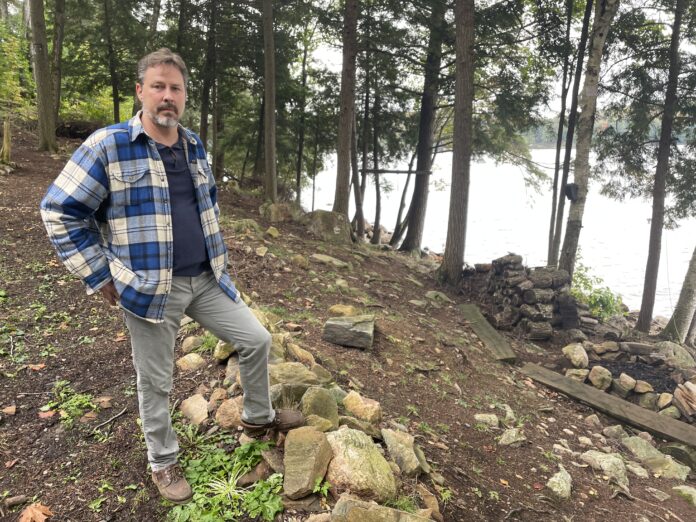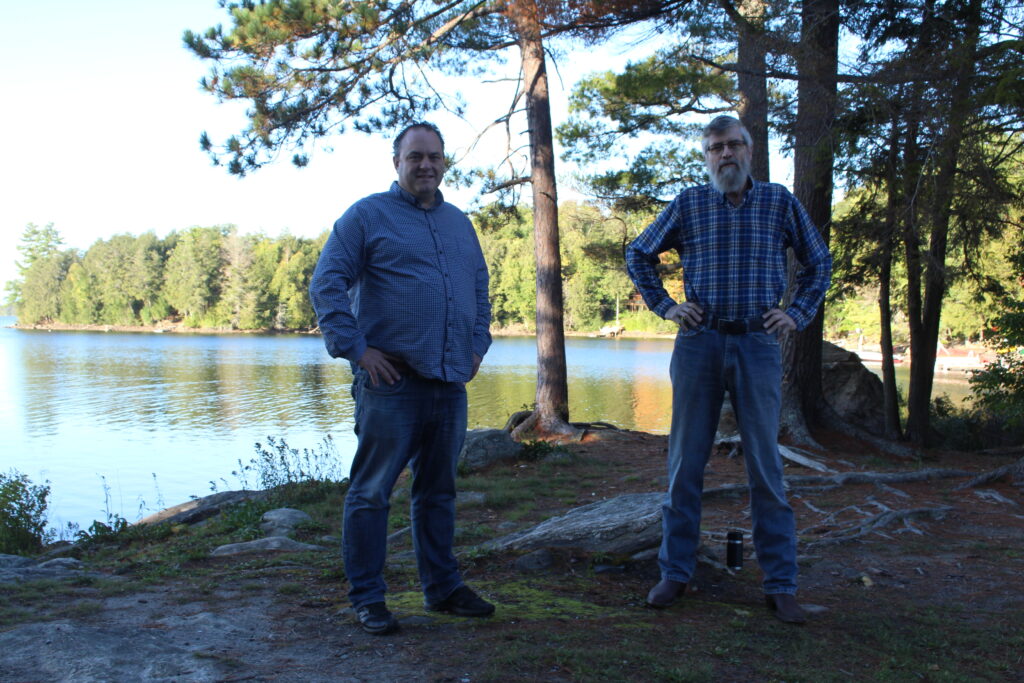

More than 100 Kushog Lake cottagers have signed a letter voicing concern over the County’s draft shoreline preservation bylaw consultation process. According to the letter sent to County councillors Sept. 22, certain cottagers and residents are “very concerned that [their] views are not being adequately represented” in the consultation process, currently facilitated by J.L Richards (JLR) and Hutchinson Environmental Sciences Ltd. (HES).
Thomas Moch, spokesperson for the group and writer of the letter, said there’s been a widespread surge of concern among cottagers across Haliburton as the consultation process enters its final stages. “Everybody on these lakes works extremely hard to have a second property. We all sacrifice a lot, to afford this,” said Moch, vice president of a Canada-wide contracting company.
“For someone to come in and say ‘we’re going to take the first 30 metres of your property and essentially expropriate it from you: everyone’s question is how can you possibly even consider that?”
“The problem right now we’re seeing is the bylaw itself and the elective and subjective input”
Brian Atkins
Moch expressed concern the process was weighted in favour of lake associations and stakeholders like BeShore Haliburton. As of press time, BeShore did not respond to three emails asking for comment. There is currently no bylaw actively being considered by County council. A previously proposed draft bylaw, being reviewed by JLR and HES, suggested restricting development and native vegetation removal within 30 metres of a shoreline’s high water mark.
It did allow property owners to clear access paths and submit permits for development projects such as the installation of docks, fire pits and decks. Brian Atkins, a Kennisis Lake cottager, has similar concerns to Moch.


He put out a call on Facebook for property owners dissatisfied with the direction of the review process to contact him. Atkins said he’s been “slammed” with messages of people voicing their support, collecting nearly 200 email addresses and names. He’s formed an unofficial group, Concerned Haliburton Waterfront PropertyOwners. “We’re not hiding behind a media budget, we’re out there. Anyone can contact us,” he said. Atkins said neither the consultants nor County council seem to be receptive to their concerns. “Here we are with our hands up in the air going talk to us, talk to us,” he said in an interview.
Warden Liz Danielsen said while not every email councillors receive, of which there have been hundreds related to the bylaw process, is replied to, they are passed on to the consultants. In an interview before the letter was submitted to council, Jason Ferrigan of JLR said his team will receive and take seriously the Kushog residents’ letter. Ferrigan said he’s been impressed by the variety of opinions expressed by property owners and stakeholders around the county.
“It demonstrates to us how much folks in Haliburton care about the quality of their lakes,” he said.
Polling lake associations
Both Moch and Atkins, as well as signatories on Moch’s letter and those who commented on Atkins’ multiple Facebook posts, expressed concern that it seemed as though the opinions of official lake associations were valued higher than individual property owners in the consultation process. “The problem right now we’re seeing is the bylaw itself and the selective and subjective input,” Atkins said, mentioning how many lakes have 40 per cent or more cottagers not a part of lake associations.
He claims the Kennisis Lake Cottage Owners’ Association (KLCOA) has voiced support for the draft bylaw as it was stated before the consultation process began, and has not been transparent with members about interactions with consultants or its connection to BeShore, of which the Coalition of Haliburton Property Owners Associations (CHA) is named as a member. BeShore has published advertisements in local media sources which include the phrase “show your support” in regards to a shoreline protection bylaw.
Debra Wratschko, KLCOA president, said the association pays a small yearly fee to the CHA to access webinars, and online tools. Approximately 50 property owners associations are part of the CHA. Wratschko said she isn’t aware of any information about the consultation process being held back from members.
She said her group has posted on the association’s website each opportunity to get involved with the draft bylaw consultation. “We did express our support to the county for a public consultation process,” said Wratschko. “We recognize we can’t represent all opinions, so for us it was important that everyone had a chance to say their piece to the county.” She said they supported the objectives of the previous draft bylaw “in principle,” in the goal of achieving good water quality and healthy lakes, but have not spoken in favour of a final bylaw direction, such as the 30-metre vegetation buffer.
She said she urges the County to “provide a clear, concise and easy to understand version of the bylaw.” Moch and others said the Kushog Lake Property Owners Association was accused of supporting the draft bylaw without member consent. However president Norma Goodger said while she supports the drafting of a bylaw consistent with science, there’s currently no bylaw on the table to support. It’s impossible to support adocument which is not currently available, nor being considered by County Council, Goodger said.
She said she seeks to inform members about opportunities to get involved. “We have no intention of dividing the community, our role is to inform,” she said. “I believe that the council members are asking very intelligent questions that are building their ability to make the right decision.” Danielsen said council has “recognized all along that lake associations don’t necessarily represent the entirety of a lake.
She said municipal officials have “tried to offer opportunities whether it’s through email or through surveys or through the online open houses” for people to be able to have their say individually. “We’ve tried our hardest to ensure everybody has a voice,” she said, mentioning that all concerned about the draft bylaw the consultants might propose in October will have many more chances to speak up before it is passed into law.
The vegetative debate

While the debate surrounding shoreline preservation bylaws in the County has been ongoing for nearly four years, Moch, Atkins and other cottagers who signed the letter take particular exception to the previously proposed 30-metre vegetative buffer, a rule they expect to see in the next draft bylaw. What that buffer means, writes Moch, is unclear as it did not specify what vegetation was considered native.
The previously proposed bylaw allowed an application process for a long list of development projects within the buffer, which Moch argues would still decrease property value and overly restrict property owners. However, a scientific literature review from consultants HES states the longer the vegetative buffer, the more effectively a shoreline will keep sediment from entering a lake. Yet if the draft bylaw, to be presented to County Council Oct. 28, recommends a 30-metre setback for all lakes, Atkins said “It imposes a one-size-fits-all solution,” which unfairly targets properties with unique topography.
Varying assessment criteria is a suggestion JLR proposed to council at its progress report in September. Moch, claiming Kushog Lake is “above the 75 per cent natural shoreline level considered to be a measure of lake health,” writes that the previously-proposed bylaw will target lakes which already are protected.”
However a 2015 report from Watersheds Canada and the Canadian Wildlife Federation scores Kushog much lower, at approximately 35 per cent naturalized shorelines. The Coalition of Haliburton Property Owners Associations (CHA) of which the KLCOA and Kushog Lake Property Owners Association are members, reports that 92 per cent of lakes in Haliburton do not meet the 75 per cent threshold.
While Moch, Atkins and the many who support their views in Moch’s letter support the current shoreline tree preservation bylaw, Environment Haliburton vice-president Terry Moore said it’s not adequately protecting Haliburton’s shorelines. “It’s an after-the-fact, complaint-based way of dealing with trees only, not shoreline vegetation writ-large,” he said.”It’s been manifestly unsuccessful to begin with, [doing nothing] to stop the degradation of the trees and vegetation around Haliburton County.”
With many speaking out against the previous tenets of the draft bylaw at town halls, online and through lake associations, Moore said he’s aware of a large community that supports stricter measures on their shoreline. “People understand that there’s a relationship between what happens on the shoreline, and what happens on the lake,” he said. Moore said he’s received rude and threatening messages online due to his support of aspects of the previously proposed bylaw.
“They want to see that protected. What they don’t want to do is be subjected to ridicule and attack on social media. It’s been ruthless,” Moore said.
Both Moore and Danielsen urged caution when discussing the future of the draft bylaw. “If people think that there’s a draft bylaw that’s on the table at County council, they’re wrong,” Moore said. “I think it’s misleading for people to start from that perspective.” The Highlander will provide a full online report of the second public town hall, hosted Sept. 29 by JLR and County Council.




